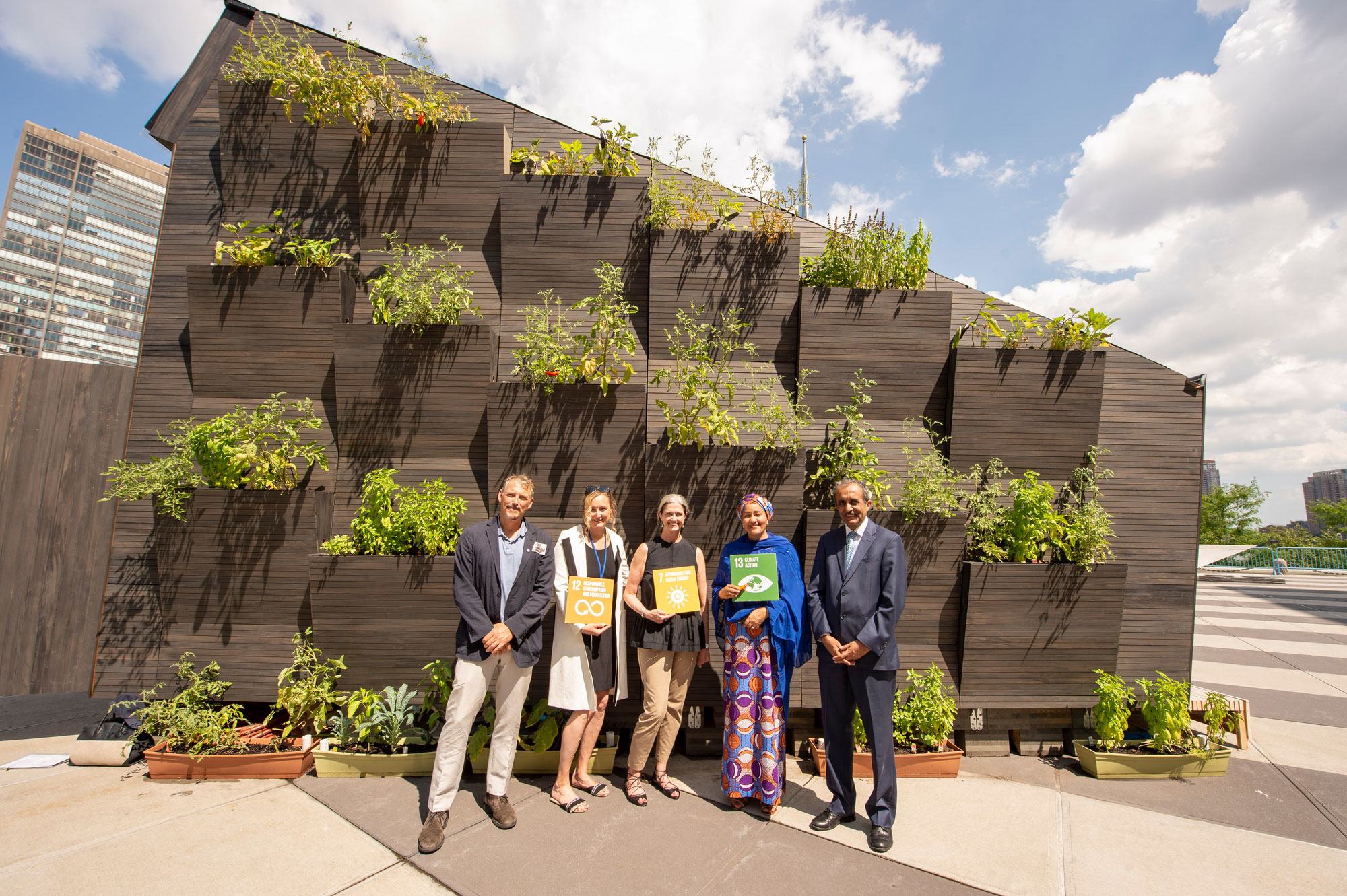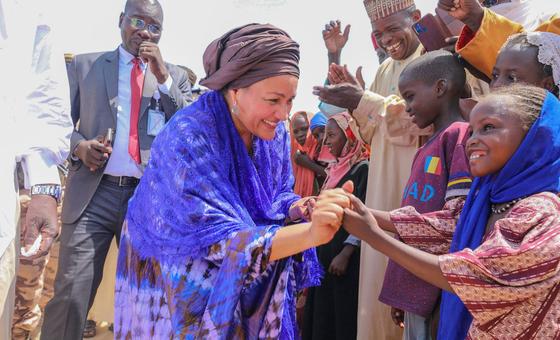The Special Event entitled Keeping the SDG Promise: Pathways for Acceleration is taking place on the sidelines of the High Level Political Forum (HLPF) now underway, aimed at getting the SDGs back on track and leaving no country behind.
It will give a boost to the so-called “High Impact Initiatives” championed by the whole UN development system and key investment strategies, while also highlighting countries.
Speaking exclusively to UN News’s Mayra Lopes, the UN deputy chief emphasized six key transition areas for accelerating the SDGs which are essential to success: food systems, energy access and affordability; digital connectivity, education, jobs and social protection; and climate change, biodiversity loss, and pollution.
The interview has been edited for clarity and length.
UN News: The global community is meeting this week at the High-Level Political Forum. We still have six years left until the 2030 deadline for the SDGs. What is your message to leaders?
Amina Mohammed: Be leaders. Be leaders for people and what they need and the promises that are made in the SDG agenda. Be leaders for the planet and the things that we need to have put in place for a 1.5-degree world.
Be leaders and inspire, that are accountable to the UN Charter. And come away from the UN knowing that this is the place where you will hear those voices and their expectations and aspirations. And that should give you the energy and the inspiration to go back and do the right thing.
UN News: The United Nations system unites around these six key transitions or pathways to acceleration. Can you tell us more about these areas and why it is so important to leave no one behind?
Amina Mohammed: We had very clear marching orders from Member States when they really did get the wake-up call of how badly off-track we were with the SDGs last year. 15 per cent, 17 per cent in some places. Not a pass mark. And for that, we had to think if this is an acceleration to 2030, what is it that would get resources in to get behind investments that would deliver on the SDGs? All 17 of them. And you’re not going to go out there talking about 17 ideas.
These are signposts for getting us to where we need to get to. So, we sort of clarified what those investments could be. Where business would come, the public sector is already there, where we could scale up, where the UN could reposition itself to help accompany countries to that. And so, those transitions made sense because we were talking about food systems.
Why were we talking about food systems? We had felt the impact of COVID and what that did to disrupt the world. We felt the impact of Ukraine on the food systems directly. We, of course, responded with the Black Sea Grain Initiative and that saved many lives.
But I think it was apparent that we could do more. And dependency on others was not always the best way to go. That is also a system that takes away from us getting to a 1.5-degree world.
The second was the transitions on energy. How do we make sure that energy gets to everyone? Access – whether it was for cooking or to small-scale industries such as education and health – and to really look at it off-grid. Not everything has to be on the grid. We can find mini-grids that power up whole communities – and especially if we were trying to link that to food systems as well.
The third was connectivity. Of course, the new technologies are here now. How do we connect people? And in this particular instance, for what? Well, for financial services for women for one. We want to make sure that you can join the world without leaving your village, on e-commerce. That needs to be powered, to be connected.
And then we also thought that, well, education is not in a good place. So, that was a fourth transition. It’s not the transformation of education we want to achieve overnight. That’s the end game of what you want to put into it. But what is the first thing that perhaps needs attention? Young people are out of work. They’ve not had the education they ought to.
You want to connect them to markets. And to do that, if you’re transforming food systems skills, how could you do that with technology and do it better and make it more equitable? Close the divides that there are today. Create jobs that people feel they are losing or have lost.
And then, to put this in context, I think of two important things: the resilience of people that needs to be supported by, I would say, a social protection floor that takes from the country’s GDP. Then, you’ve got some resilience, and you can ensure that when you have these big knocks like COVID-19, that people are not knocked off track.
Last but not least, the enabling environment will become more difficult if we don’t take cognizance of what we would call the triple crisis: climate, biodiversity, and pollution.
UN News: I want to refer to the digital innovation part. I wanted to hear if you feel hopeful and how you think we can leverage this new technology?
Amina Mohammed: There was a gentleman who I met recently in Barbados. And he was the one who designed the search engine, the very first one we had called Archie. I said to him, so you tell me, what do you think about this new era of technology that you’re obviously very familiar with? And he said, “It’s very exciting, it’s very scary, and we’re not ready”. And I thought, well, that probably captured the reality.
The Secretary-General has put in place his offer to the Summit of the Future of how to put the guardrails around the potentials. There is a dark side to it, but there are so many opportunities, and I think that structure will help us to be safer.
It will help us to go further in a world that’s connected and we must do things about governance, about the way in which technology is used, whether it’s algorithms that are designed, have a bias against women.
But I think what is more important is when I said to him: “Is this like going from the horse and cart to the combustion engine when we industrialized?”. And he said, “No, it’s much more than that – because you’re talking about changing societies and the way we do things”. We will never be the same again because we will be so much more connected.

UN Deputy Secretary-General Amina Mohammed addresses the opening of the High-level Political Forum 2024.
UN News: We are talking a lot about the SDG acceleration, but we have a very challenging landscape right now with wars and global tensions. How do you think we can still push for SDG acceleration in this scenario?
Amina Mohammed: Well, back to your first question. We need leadership. We need leadership at all levels. That’s not just the president of a country, but in all constituencies, business, civil society, young people.
That will be a key part of what should make us hopeful. Rebirthing the United Nations [as] a stronger town hall for a global village, so that voices here are not only heard but acted upon.
We don’t all have the same muscle on that floor, but we do have a voice, and we can take that out and we must remember every day that the representation of our people is so diverse, and the needs are so complex.
Perhaps more important to me is how we find the resources for the development agenda, for peace, for security. But not security in the way in which we pay for war; but security in which we invest in the prevention – which is development.
We find ourselves in a system which was designed for a 1945 recovery from World War Two. “May we never know the scourge of war again”. But we have. And the same principles we applied then, which was to say people have to have access to resources to rebuild their lives, are exactly the same principles we need to have today to say you need to have long term financing for your development, wherever you are in the world.

Deputy Secretary-General Amina Mohammed (2nd right) visits an Ecological Living Module, a demonstration of eco-friendly and affordable housing exhibited at UN Headquarters in New York. (file)
My hope is that acceleration happens because we all understand there’s an existential threat with a 1.5-degree world hanging in the balance, that people will no longer sit on the sidelines.
And how they react depends on how much injustice they think they’re being meted out by their local leadership, national leadership, and international leadership. So, this is a globe very much connected. Young people are full of energy. They are anxious because they don’t see a future.
If I go back to the creation of many terrorists, they’re not born. It’s an environment that excludes, an environment of injustice, an environment of no hope.
And therefore, a young person finds themselves easy fodder for those who would like to disrupt, in a way that is unfortunate.
So, I have hope that we have never been more equipped in a world with resources to do the right thing. We have an amazing framework and path to this through the SDGs. And I think that we should just get up and race this last mile and then deliver the promise of the SDGs.

